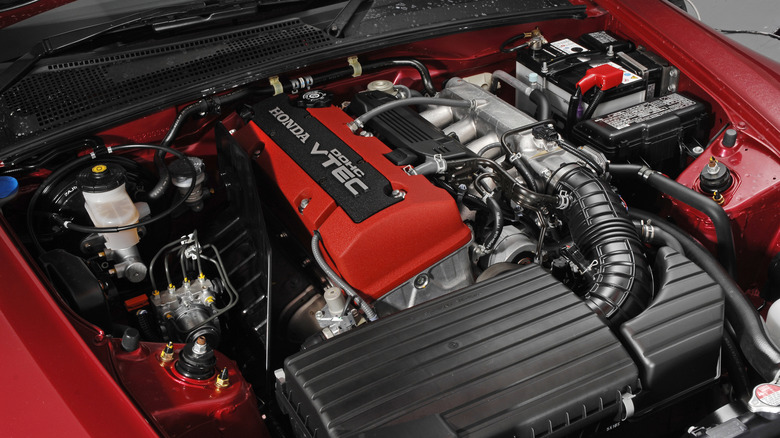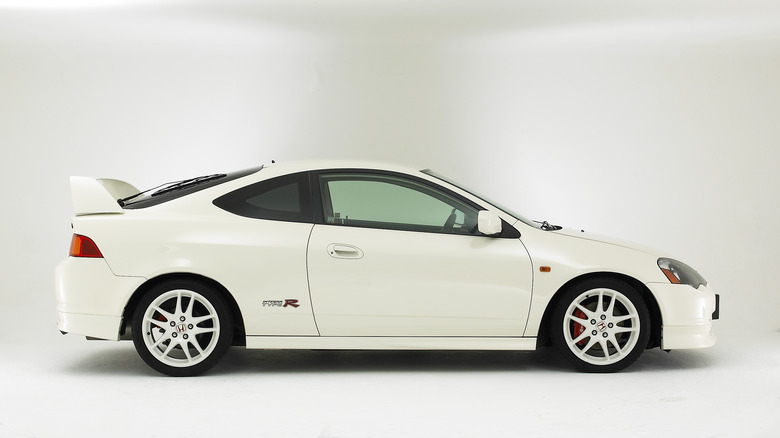
Heritage Images/Getty Images
Honda is famous for its four-cylinder engines, with several distinct series fulfilling a variety of purposes. The F-Series is one of the more unusual series, as it wasn’t initially developed as a high-performance engine line until the introduction of the F20C. The high-revving four-cylinder remains one of the best-known JDM engines of its era and is widely considered to be among the most impressive naturally aspirated engines ever made. But, like many Honda engines, the F-Series was a versatile family that also featured in a wide range of cars from a British luxury sedan to an all-American coupe.
These weren’t the highest horsepower engines Honda ever built: Aside from the F20C and F22C1, the other engines in the F-Series family never gained much of a reputation among enthusiasts, with the H-Series and K-Series instead being the preferred engine swap options for many. Instead, the F-Series served mostly as efficient, reliable workhorses, pushing out respectable power figures in the strong-selling Accord sedan and its derivatives.
The F-Series’ British connection
Before it imploded under the ownership of BMW in the mid-’90s, Rover was one of the UK’s best-known car brands. Rover Group and Honda had been in partnership since the early ’80s, with the British brand selling several rebadged versions of Honda’s cars. One such car was the Rover 600, which debuted in 1993 and featured a choice of either 1.8-liter or 2.0-liter Honda F-Series engines under the hood.
Those engines were shared with the British market Accord, with which the Rover also shared its platform. The 1.8-liter engine acted as an entry-level option for the 600, which was positioned as a British-built alternative to the BMW 3 Series that was dominating sales charts at the time. BMW itself acquired Rover Group in 1994 — beating a rival offer from Honda in the process — but continued production of the 600 until 1999. By the time production ended, relationships between the now German-owned Rover marque and Honda had soured, and so no further Rovers were developed with Honda engines.
[Featured image by Crash71100 via Wikimedia Commons | Cropped and scaled | CC0 1.0]
When is an Accord not an Accord?
Another lesser-known car to feature an F-Series engine was the Honda Ascot Innova. It was heavily based on the British market Accord, which was a separate car from the Japanese market model of the same name. It was marketed as an upscale option in Honda’s sprawling JDM range at the time, which also included the related Ascot and mid-range JDM Accord. The car featured a choice of several 2.0-liter F20A engines at its launch in 1992, with both SOHC and DOHC variants available. In DOHC form, the engine produced just shy of 150 horsepower. A larger 2.3-liter H-Series engine was also offered in top-spec examples of the car.
The Ascot Innova offered a sportier take on the traditional sedan shape, with a more sloped, aerodynamic appearance similar to that of the Prelude. Its production lifespan was relatively short, only lasting until 1996, by which time sedans as a segment were beginning to lose their appeal in Japan. As such, it was never directly replaced, but its combination of a premium interior and attractive styling has ensured the Ascot Innova retains a small but enthusiastic fanbase in Japan today.
It powered the Honda Aerodeck (not the famous one)
An F-Series engine could also be found under one of the most obscure variants of the Accord, the ’90s European market Accord Aerodeck. The Aerodeck name was used on multiple Accord variants throughout the ’80s and ’90s, first as a two-door shooting brake and later as a more traditional four-door wagon. The latter featured a 2.0-liter F20B3 engine.
The two-door variant is the version best remembered by enthusiasts today, mainly due to its uniquely angular design. Some elements of that design were carried over to the later four-door, including the greenhouse-like rear window and high rear roofline. The styling allowed both Aerodeck variants more cargo space than their traditionally styled sedan equivalents, although pure practicality alone was never the selling point of either Aerodeck variant — instead, it was more of a novelty factor. Since the later car’s styling was much more in line with the rest of the European market Accord range, it’s been largely forgotten in the decades since production ended.
[Featured image by Kieran White via Wikimedia Commons | Cropped and scaled | CC BY 2.0]
An all-new version was developed for the Acura CL
Honda overhauled its F-Series design for the 1998 Acura CL, which featured a 2.3-liter four-cylinder, internally referred to as the F23A1. The engine, which Honda noted was «completely re-engineered,» was a SOHC design with fuel injection and VTEC. It was designed to run quieter and smoother than other engines in the F-Series family, with the goal of competing against rivals like the BMW 3 Series and Lexus SC300. It sported a competitive 150 horsepower and produced 154 lb-ft of torque at 4,800 rpm.
Honda put a lot of effort into differentiating the CL from previous Acura products, emphasizing at the time of its launch that it was the first Acura-branded car to be made in the United States. While hardly a runaway success, the first generation CL sold well enough to warrant a follow-up generation, which was unveiled for the 2000 model year.
An F-Series engine powered a long forgotten minivan
The two-row SUV Honda Passport is now a mainstay in the automaker’s range, but the nameplate was first used on a rebadged Isuzu Rodeo SUV in the ’90s. Honda would import Isuzus and sell them as Passports, and in return, Isuzu borrowed a Honda model and rebadged it for its own lineup. That model was the Isuzu Oasis, a rebadged Odyssey minivan that’s today extremely rare.
The changes between the Odyssey and Oasis were only minimal: a new badge on the steering wheel, a grille with an Isuzu logo, and new wheels. Everything else, including the F22B6 engine, was carried over from the Honda. It was designed to be a workhorse, with 2.2 liters of displacement, four cylinders, and a tried-and-tested design that ensured optimal reliability. The Odyssey became a sales success, but buyers weren’t interested in the Oasis, despite the fact that the two cars were identical underneath.
[Featured image by IFCAR via Wikimedia Commons | Cropped and scaled | Public Domain]
The unique F20C
By far the best-known variant of the Honda F-Series engine family is the F20C that powered the S2000 roadster. Not only did it boast impressive performance, but it also proved exceptionally durable. SlashGear even crowned it one of the most reliable Honda engines ever built. The F20C’s appeal lies in its rev-happy nature, with the engine requiring a thorough workout to get the best out of it. It’s happiest in the higher half of its range — and at its best close to its 9,000 rpm redline — making it unique among sports cars both past and present.
Most modern competitors use forced induction to boost their power outputs, but what made the F20C so special was that it didn’t need a big turbo to generate power. Instead, Honda’s engineers built an engine with unprecedented specific power output — 124 horsepower per liter in the JDM S2000, to be exact. That gave it an output of almost 250 horsepower in a naturally aspirated engine no bigger than that of a regular Accord sedan.
The F20C’s bigger successor
Despite it now being regarded as one of Honda’s best engines, not everyone was quite so impressed by the F20C at the time of its launch. Some drivers complained there wasn’t enough low-end torque, and so to fix this, Honda unveiled the AP2 S2000 for the U.S. market with a larger 2.2-liter engine. Internally given the engine code F22C1, the revised engine made 162 lb-ft of torque at 6,800 rpm, but featured one key compromise as a result.
Rather than the sky-high 9,000 rpm redline of the F20C, the F22C1 featured a slightly lowered 8,000 rpm redline. That was still higher than nearly every other sports car on the market, and hardly much of a compromise for buyers. Alongside the larger, torquier engine, the AP2 S2000 also benefited from a suspension overhaul to make it easier to drive than the notoriously snappy original car.
The K-Series outshined the F-Series

Heritage Images/Getty Images
The history of the Honda F-Series is a tale of two halves: The F20 and F22C1 remain highly regarded among enthusiasts, but almost every other variant of the family has been forgotten. Some would say that fate is deserved — after all, other four-cylinder Honda engines produced higher power outputs and boasted better tuning potential. In particular, the K-Series, first introduced in 2001, has become the go-to for all manner of tuning projects.
The Honda K-Series first appeared in the Type R Civic and Integra, and it wasn’t solely a performance engine. It also later appeared in the Accord sedan after the F-Series was phased out, along with multiple Acura models. Aftermarket support has grown in the years since it debuted, and today it’s possible for the most determined builders to achieve up to 1,000 horsepower with the best K-Series engines. As for the F-Series? Except for the S2000 engines, it’s mostly relegated to the archives, along with many of the family favorites it powered.